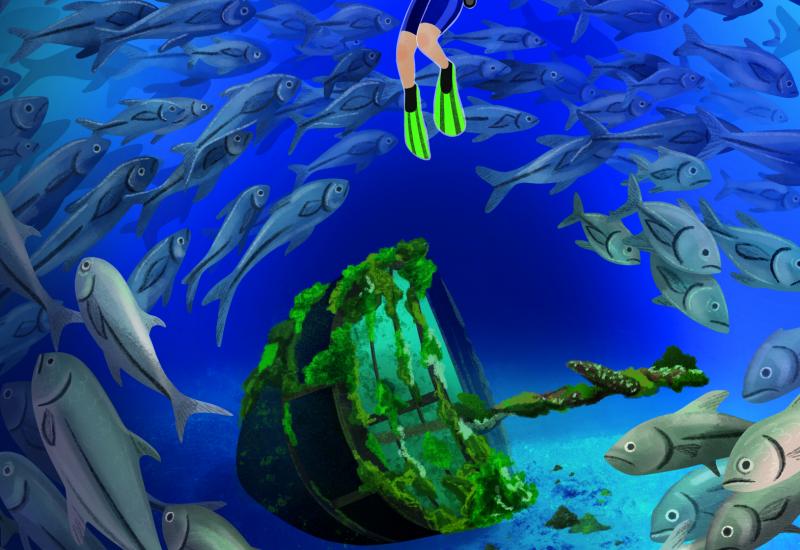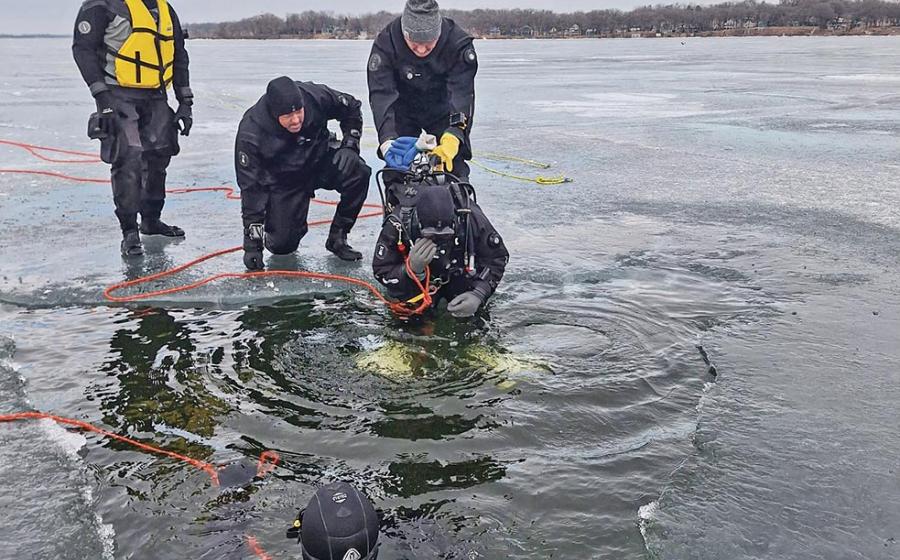Where Oceans Collide - Sulawesi

Sea Oddity Dusk diving in Lembeh Strait to spot the mating antics of the shy, flamboyantly patterned mandarinfish is a must. Just before sunset is the magic hour for mandarin romance, so save your own happy hour for later.
The odd shape of this island northeast of Bali gets a lot of attention — does Sulawesi resemble a spider, a giant crab or a starfish? Divers lose little sleep wondering, as the underwater world here is simply all consuming in its biodiversity, color and fantastical inhabitants. No place on the island is farther than 25 miles from the sea, but North Sulawesi yields the best treasures for divers. Bunaken National Marine Park, about five miles offshore, covers the northern tip of Sulawesi. The protected area encompasses several mangrove-fringed white-sand islands surrounded by coral reefs with steep walls that teem with ghost pipefish, nudibranchs, bumphead parrotfish, Napoleon wrasse, cuttlefish, mandarinfish, pygmy seahorses and a world of anemones and their playful denizens. Giant clams abound. Colubrine sea snakes, with starkly contrasting bands, twist like ribbons through the coral. Dolphins and hawksbill sea turtles are frequently spotted too. When it comes to marine biodiversity, North Sulawesi is Indonesia’s epicenter and home to one of the most diverse coral ecosystems on the planet. More than 1,000 reef-associated fish species have been identified in North Sulawesi — more than anywhere else on Earth. And there are an estimated 150 dive sites in the area for taking it all in. At Sachiko’s Point, off the Northeast side of Bunaken Island, look for reef sharks, slews of schooling redtooth triggerfish and surprises like the pyramid butterflyfish, recognized by the white pyramid shape festooning one side of its body. An impressive vertical wall lures divers south of Bunaken Island to the dive site called Lekuan I, where turtles rest on rock coral ledges and fairy basslets create a cacophony of color swarming in the shallows. On the eastern side of Sulawesi’s northern tip lies the Lembeh Strait, another must-dive destination. The most famed denizens here are the mandarinfish and the fascinating mimic octopus. Discovered in 1998, the mimic octopus plays copycat to avoid predators, mimicking the form and movement of a sea snake, shark, flounder, lionfish, mantis shrimp and more. It’s simply hallucinatory to see this creature in action. The Lembeh Strait is also widely regarded as the muck-diving capital of the world, yielding frequent sightings of frogfish, harlequin shrimp, weedy scorpionfish, stonefish and more. — TW
Need to Know
Travel Tip: If you’re visiting Sulawesi during July and August, consider working time into your schedule for a cultural excursion to Tana Toraja in South Sulawesi, where fascinating funeral rites take place in mountainous surrounds. When to Go: Year-round, but July to September is peak dry season, with calm seas and the best visibility. Getting There: There are daily flights from Denpasar (DPS) and Jakarta (JKT) to Manado (MDC) as well as international connections from Singapore and Davao in the Philippines. Resorts provide bus and boat transport from Manado. Check Singapore Airlines (www.singaporeair.com) and Garuda (www.garuda-indonesia.com) for schedules. Operators/Accommodations: Living Colours Diving (www.livingcoloursdiving.com), Lembeh Resort (www.lembehresort.com); and Peter Hughes Paradise Dancer live-aboard (www.peterhughes.com) Dive Conditions: Average visibility of 65 to 100 feet, but up to 130 feet is sometimes possible. Water temperatures average 84°F. Price Tag: Living Colours Diving on Bunaken Island offers three-night packages with four dives for approximately $280 per person. Lembeh Resort on Lembeh Island offers three-night packages with full board and five boat dives for $645 per person. Eleven-night cruises on the Paradise Dancer start at $4,750 per person.

Sea Oddity Dusk diving in Lembeh Strait to spot the mating antics of the shy, flamboyantly patterned mandarinfish is a must. Just before sunset is the magic hour for mandarin romance, so save your own happy hour for later.
The odd shape of this island northeast of Bali gets a lot of attention — does Sulawesi resemble a spider, a giant crab or a starfish? Divers lose little sleep wondering, as the underwater world here is simply all consuming in its biodiversity, color and fantastical inhabitants. No place on the island is farther than 25 miles from the sea, but North Sulawesi yields the best treasures for divers. Bunaken National Marine Park, about five miles offshore, covers the northern tip of Sulawesi. The protected area encompasses several mangrove-fringed white-sand islands surrounded by coral reefs with steep walls that teem with ghost pipefish, nudibranchs, bumphead parrotfish, Napoleon wrasse, cuttlefish, mandarinfish, pygmy seahorses and a world of anemones and their playful denizens. Giant clams abound. Colubrine sea snakes, with starkly contrasting bands, twist like ribbons through the coral. Dolphins and hawksbill sea turtles are frequently spotted too. When it comes to marine biodiversity, North Sulawesi is Indonesia’s epicenter and home to one of the most diverse coral ecosystems on the planet. More than 1,000 reef-associated fish species have been identified in North Sulawesi — more than anywhere else on Earth. And there are an estimated 150 dive sites in the area for taking it all in. At Sachiko’s Point, off the Northeast side of Bunaken Island, look for reef sharks, slews of schooling redtooth triggerfish and surprises like the pyramid butterflyfish, recognized by the white pyramid shape festooning one side of its body. An impressive vertical wall lures divers south of Bunaken Island to the dive site called Lekuan I, where turtles rest on rock coral ledges and fairy basslets create a cacophony of color swarming in the shallows. On the eastern side of Sulawesi’s northern tip lies the Lembeh Strait, another must-dive destination. The most famed denizens here are the mandarinfish and the fascinating mimic octopus. Discovered in 1998, the mimic octopus plays copycat to avoid predators, mimicking the form and movement of a sea snake, shark, flounder, lionfish, mantis shrimp and more. It’s simply hallucinatory to see this creature in action. The Lembeh Strait is also widely regarded as the muck-diving capital of the world, yielding frequent sightings of frogfish, harlequin shrimp, weedy scorpionfish, stonefish and more. — TW
Need to Know
Travel Tip: If you’re visiting Sulawesi during July and August, consider working time into your schedule for a cultural excursion to Tana Toraja in South Sulawesi, where fascinating funeral rites take place in mountainous surrounds. When to Go: Year-round, but July to September is peak dry season, with calm seas and the best visibility. Getting There: There are daily flights from Denpasar (DPS) and Jakarta (JKT) to Manado (MDC) as well as international connections from Singapore and Davao in the Philippines. Resorts provide bus and boat transport from Manado. Check Singapore Airlines (www.singaporeair.com) and Garuda (www.garuda-indonesia.com) for schedules. Operators/Accommodations: Living Colours Diving (www.livingcoloursdiving.com), Lembeh Resort (www.lembehresort.com); and Peter Hughes Paradise Dancer live-aboard (www.peterhughes.com) Dive Conditions: Average visibility of 65 to 100 feet, but up to 130 feet is sometimes possible. Water temperatures average 84°F. Price Tag: Living Colours Diving on Bunaken Island offers three-night packages with four dives for approximately $280 per person. Lembeh Resort on Lembeh Island offers three-night packages with full board and five boat dives for $645 per person. Eleven-night cruises on the Paradise Dancer start at $4,750 per person.










